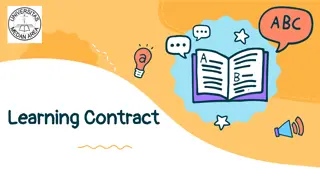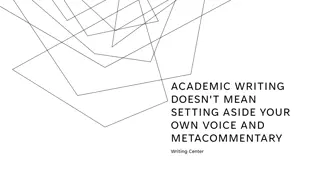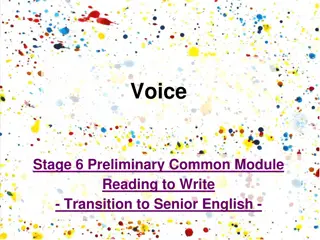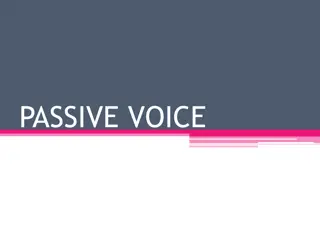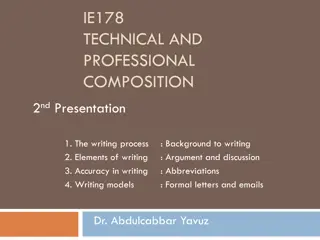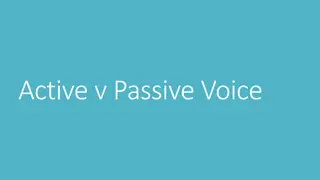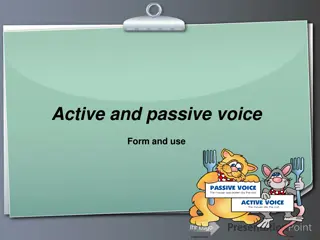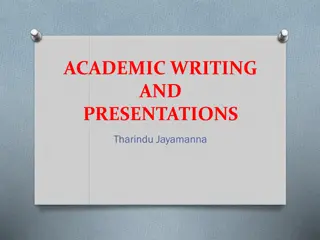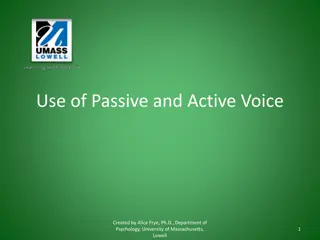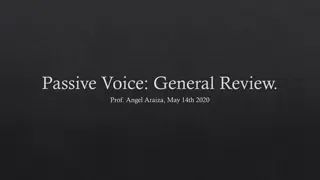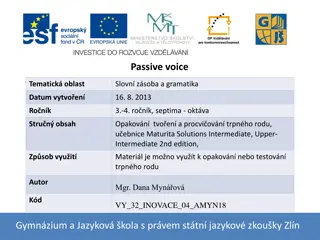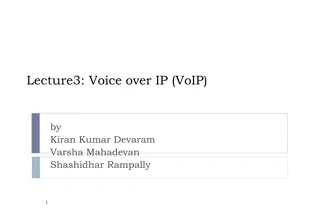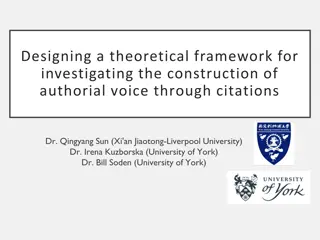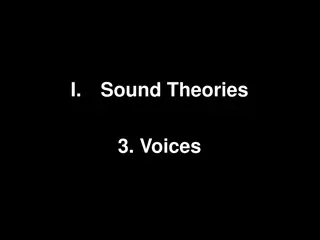Understanding Voice in Academic Writing: A Comprehensive Overview
Delve into the nuanced concept of voice in academic writing through a discussion of its definitions, classroom implications, evaluation aspects impacted by identities, and the importance of writer ownership. Explore the complex interplay of textual and non-textual elements shaping writer identity. Consider resources available in EAP classrooms for enhancing student expression of voice while addressing issues like stance and hedging.
Uploaded on Sep 17, 2024 | 0 Views
Download Presentation

Please find below an Image/Link to download the presentation.
The content on the website is provided AS IS for your information and personal use only. It may not be sold, licensed, or shared on other websites without obtaining consent from the author. Download presentation by click this link. If you encounter any issues during the download, it is possible that the publisher has removed the file from their server.
E N D
Presentation Transcript
What do we teach when we teach voice? Dr Maureen Finn York BALEAP PIM 19 November 2021 1
Overview Definitions of voice What happens in our classrooms? Revisiting and repurposing language for the expression of voice What might we want to do differently? Ownership of voice in our classrooms 2
Aspects of voice evaluation (Hood, 2010; Hyland, 2012) affected by complex identities of race, class and gender (e.g. Benesch, 2009; Lea and Street, 1998; Ivani ,1997) voice as the cumulative effect of writer choices As EAP practitioners, it is difficult for us to position ourselves within this wide range of definitions and functions. 3
Dr Ellie Cartwright, PG supervisor Cardiovascular Sciences I think the problems that are encountered is that there is an awful lot of literature to review and it s selecting the right literature to support your arguments and remembering that this is your research and that the literature needs to support your research and your discussion and your arguments, not somebody else s, not what s been done before particularly so you need to gather all that information and formulate it in a way that tells your story that you want to tell. 4
Conclusions (so far ) voice involves writer identity and evaluation socially constructed it includes both textual and non-textual elements cumulative effect of writer choices 5
In the EAP classroom What happens in our classrooms? What resources do we have available to us to develop students expression of voice? 6
What about stance? (1) While that may be true, the circumstances pertaining to this case (2) show clearly that (3) it makes sense to allow the horizontal price-fixing, except with lower prices. (Econ-HG).Lancaster, 2016 (1) interactional (2) epistemic (3) attitudinal 7
What about hedging? mitigation of claims (Hyland, 1998) pragmatic caution (Hyland 1998) to indicate lack of commitment and to open up dialogue within the text (Bruce, 2020a, 2020b) writer comment on the truth-value of the research reported on 8
What about referencing? attribution/referenced sentences averral/unreferenced sentences 9
Materials and the classroom confusion between terms (voice, stance, hedging, position, claim) often used interchangeably over-narrowing of both concept and linguistic expression (What sentence indicates voice? Your choice of reporting verb indicates your voice.) limited use of the type of texts relevant to students to demonstrate disciplinary (textual and non-textual) construction of voice 10
The study purpose-built 30,000 word corpora from two disciplines, student theses which were first-time passes in the Faculty of Medical and Health Sciences close textual analysis using annotation tool brat v1.3 (Stenetorp et al., 2020), using a framework from a computational linguistics study in biomedical sciences 11
Revisiting and repurposing language: referencing and rhetorical impact Non-referenced sentences Averral Malnutrition is a worldwide phenomenon, characterised by over- and under-nutrition. NMS202_01R_Ex01 Self-reference During this PhD study the main aim is to identify the signalling pathway IL-10 takes to reduce the inflammatory cytokines in the heart during pathological hypertrophy. CV102_04R_Ex07 12
Non-referenced sentences Emphasised Secondly, the researcher examined the qualitative studies with regard to the sample size. NMS206_03R_Ex06 Hidden Firstly, stimuli that are known to increase ceramide levels, such as TNFa and oxidative stress, are also known to promote vascular calcification (see section 1.5), suggesting that ceramide levels may increase during VSMC matrix mineralisation. CV107_05R_Ex09 13
What might we want to do differently? referencing as a system is frequently taught impact of referencing choices on the reader less frequently discussed observable and teachable 14
Revisiting and repurposing language: evaluation and degrees of certainty Porrello et al., (2011) resected the left ventricular apex of mice one day after birth. CV108_04R_Ex07 Sellen (2001b) found that children were usually given stiff maize porridge.NMS202_05R_Ex09 Overall, the study concludes that( ). NMS208_3R_Ex05 The full report of the pilot suggests that a daily full- body emollient therapy from birth can prevent atopic eczema (Simpson et al. 2014). NMS201_05R_Ex10 15
Evaluation as students critical analysis Hidden averral Firstly, stimuli that are known to increase ceramide levels ( ) are also known to promote vascular calcification ( ), suggesting that ceramide levels may increase during VSMC matrix mineralisation. CV107_05R_Ex09 Collectively the studies demonstratethat ( ). CV102_02R_Ex04 16
What might we want to do differently? develop awareness of how writers in disciplines comment on the truth-value of the research reported on observable and teachable 17
Text analysis analysis of target texts (exemplary texts, contextualised language) drawing together abstract concepts (e.g. voice) and their expression on the page a co-operative venture, drawing on students disciplinary knowledge discussion of specific linguistic elements, their impact on the reader and their form 19
Task Two: writers voice as averral and attribution, and epistemic stance Some studies have suggested that individuals with low socio-economic status are more likely to have more respiratory virus infections (62;63) and more severe outcome (10;15). Presumably because they are more likely to live in an overcrowded household, have poor nutrition leading to lower immunity have high prevalence of risky behaviours like smoking or may lack information about vaccination and other types of medical care and hence access medical services to a lesser extent. However, other studies have found no such link (64-67). Further, prematurity and low birthweight have been identified as risk factors to severe respiratory disease (22;23;53). For example, in their study, Jackson et al (23) found that underweight children were five times more likely to develop ALRI. Goka, E.A.C. (2014). 21
Writers voice as averral and attribution and epistemic stance Some studies have suggested that individuals with low socio-economic status are more likely to have more respiratory virus infections (62;63) and more severe outcome (10;15). Presumably because they are more likely to live in an overcrowded household, have poor nutrition leading to lower immunity have high prevalence of risky behaviours like smoking or may lack information about vaccination and other types of medical care and hence access medical services to a lesser extent. However, other studies have found no such link (64-67). Further, prematurity and low birthweight have been identified as risk factors to severe respiratory disease (22;23;53). For example, in their study, Jackson et al (23) found that underweight children were five times more likely to develop ALRI. 22
Writers voice as averral and attribution and epistemic stance Some studies have suggested that individuals with low socio-economic status are more likely to have more respiratory virus infections (62;63) and more severe outcome (10;15). Presumably because they are more likely to live in an overcrowded household, have poor nutrition leading to lower immunity have high prevalence of risky behaviours like smoking or may lack information about vaccination and other types of medical care and hence access medical services to a lesser extent. However, other studies have found no such link (64-67). Further, prematurity and low birthweight have been identified as risk factors to severe respiratory disease (22;23;53). For example, in their study, Jackson et al (23) found that underweight children were five times more likely to develop ALRI. 23
Ownership of voice in our classrooms? QUESTIONS AND DISCUSSION 24
List of references Benesch, S. (2009) 'Theorizing and practicing critical english for academic purposes', Journal of English for Academic Purposes, 8(2), 81-85. Bruce, I. (2020a) 'Is critical thinking a useful concept in teaching EAP? If so, where does it fit into our crowded curriculum?', Teaching EAP, 25 June 2020, available: https://teachingeap.wordpress.com/2020/06/25/is-critical-thinking-a- useful-concept-in-teaching-eap-if-so-where-does-it-fit-into-our-crowded- curriculum/ [accessed 22 December 2020]. Bruce, I. (2020b) 'EAP and Expressing Critical Thinking through Text: Theory and Pedagogy', in celt.leeds.ac.uk/summer-conference, econference, available: https://celt.leeds.ac.uk/ian-bruce-eap-and-expressing-critical-thinking-through- text-theory-and-pedagogy/ [accessed 24 April 2021]. 25
List of references Goka, E.A.C. (2014). Influenza A viruses dual and multiple infections with other respiratory viruses and the risk of hospitalization and mortality. Thesis. The University of Manchester. Hood, S. (2010) Appraising Research: Evaluation in Academic Writing, Basingstoke: Palgrave Macmillan. Hyland, K. (1998) Hedging in Scientific Research Articles, Amsterdam: John Benjamins Publishing Company. 26
List of references Ivani , R. (1997) Writing and Identity The Discoursal Construction of Identity in Academic Writing, Amsterdam/Philadelphia: John Benjamins Publishing Company Lancaster, Z. (2016) 'Expressing stance in undergraduate writing: Discipline- specific and general qualities', Journal of English for Academic Purposes, 23, 16-30. Lea, M. and Street, B.V. (1998) 'Student Writing in Higher Education: an academic literacies approach', Studies in Higher Education, 23(2), 157-172. 27


